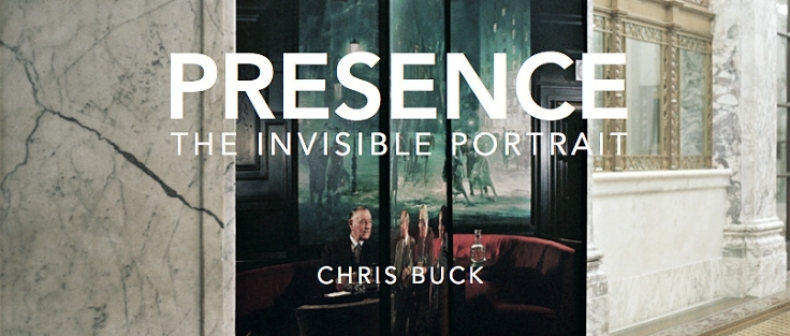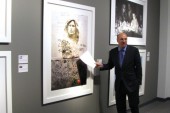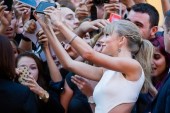
The cover of PRESENCE: The Invisible Portrait
Chris Buck, photographer to the stars, has met and photographed the likes of Jay-Z, William Shatner, Johnny Depp, Jimmy Page, Jonathan Franzen, Louis C.K., Andy Samberg, Willie Nelson, the list goes on… and on.
His newest project features celebrity portraits of a different variety. The photographs employ celebrities who are very much present in the frame, yet are invisible to the viewer. At first the images read as confusing, and at times are even frustrating. Yet I found myself coming back to the images over and over again, being drawn to the transcendent aura that the photographs emit. After further inspection I noticed a subtlety that only a photographer of Buck’s caliber could execute so seamlessly; interwoven between the pages are testaments to the celebrity’s presence, miniature notions of fame, and humour slathered on in a veil thick and sweet as honey. The book aptly titled PRESENCE: The Invisible Portrait is not only innovative, but breathes life into the traditional portrait.
I spoke to Buck about where the idea came from, the resistance he was met with (from celebrities and the publishing world alike) when composing the book, and after 20 years of photographing the biggest stars, if he ever gets star-struck.
CM: Tell me about where the idea to shoot hidden celebrities came from
CB: I was trying to think of something to do as a promotional piece for myself as a photographer and I’ve always liked out-there ideas and conceptual things that were provocative, but also kind of charming. It really took off from there, I almost dared myself by saying, “Can I do this? Can I not only get away with it with the public but can I do this and hold my ground?” It was a challenge to myself.
CM: Were you met with any resistance from celebrities while shooting?
CB: Some people would say, “If I’m not visible why do I have to do it?” or, “Can’t you just say I did it and put my name on it?” That became a bit of a struggle. There were people who wouldn’t do it out of just not wanting to give their time. They’d say, “Just take a picture of something and say I’m in it.” Like Fran Lebowitz, I asked her to do it and Ewan McGowan I asked him to do it. Ewan McGowan said, “Come to my event and frame the picture so I’m not in it, so I’m just outside the frame.” I said, “Well I kind of need you to be actively cooperating, I can’t just shoot you at a public event.”
Whoopi Goldberg overtly said she would not do it. She didn’t say why. She just looked at the mockup and clearly found it intriguing because she spent a lot of time with it. Then in the end she wouldn’t make the time to do it and, I don’t know, my guess is she felt that she worked hard to be visible and wasn’t really interested in not being visible.
CM: I’ve heard you talk about the importance of reacting against something versus being influenced by it, was there something you were reacting against when you were shooting the invisible portrait series?
CB: There really is an aspect of reacting against that I think is very important for artists who are very good. It certainly affected me in the beginning of my career when I was inspired by showing people how portraits should be done. I felt like most portraits that were done were not done right.
CM: In the photographs I noticed a subtle connection between the celebrity and the location. Was the connection between the subject and the location done on purpose?
CB: When people first see the series they think it might be a spot that the celebrity picked out, or maybe somewhere in their home or somewhere of meaning, like what you’re saying, that there’s a literal connection. That’s one of the reasons why it was important to actually have the celebrity in the shot and not just connect in a more theoretical way. The fact that they’re actually in there immunes the shot with their essence. I could shoot things that seemed to have no literal connection to them, but the fact that they’re there makes the connection become literal.
William Shatner’s portraitCM: The first photo you did for the series was with William Shatner five years ago; when you were shooting Shatner did you have the intention of publishing an art photography book?
CB: At first I shot Shatner and then a week later I shot Andy Samberg. After I did those first couple I found there was a lot going on in the pictures visually, in terms of texture and colour that I never really imagined would happen. I thought, ‘even if half of them have this much visual interest, this could be a really cool project.’ Then I began to think about how I wanted to shoot 200 all together and have it be a giant book of 200 images and it would just be totally fucked up like, ‘Someone spent 5 or 7 years shooting this and the celebrities aren’t even visible! Like what kind of freak did this book?!’
CM: How did the transition from editorial and advertising photography to publishing an art book go?
CB: I did have a hard time finding a publisher. I don’t know if it had to do with the fact that I was a celebrity photographer and that it was an ‘unsatisfying celebrity book,’ or if it was a fine art book done by someone who had no fine art reputation. In theory, the fine art world is supposed to be all about the merit of the work, but the fact is the art world is driven so much by the reputation of each individual artist and whether that caries any cache or not. I think, in coming from the commercial world, it’s not that I’m not taken seriously– it’s just that I’m not even known at all.
Robert Di Nero’s portraitCM: I was actually reading some of the comments on Huffington Post and other websites about the book where people didn’t really understand what you’re doing. Do you have anything you’d like to say to those people?
CB: Their dissatisfaction is valid, but there is not necessarily meant to be an obvious connection. I’m very satisfied with things being mysterious and unresolved. I would invite people to be ok with the lack of resolution.
CM: And some of the best art, I would say, doesn’t have a resolution. It’s also something completely new, I would say that’s what PRESENCE is, it’s something completely new.
CB: I hope it’s that. When I was approaching publishers one of the top publishers in the world wrote me back and said, ‘We’re not taking it on but I have to say this definitely raised a level of curiosity among our office staff.’ Another one said, ‘I have to say I’ve never seen anything quite like this.’
This work, I think, will be understood better in 10 years than it is now. I think that’s very exciting.
CM: I have to ask, after years of photographing the biggest celebrities, do you ever get star-struck when you see any of these people that have changed culture?
CB: Of course! Hey I spent like 20 minutes with Jimmy Page one day and it was awesome- I was floating on air. I wouldn’t be shooting celebrities if I wasn’t interested in them.
CM: When you were first starting off as a photographer, did you have any sort of mentality that enabled you to get to where you are today?
CB: When I finished college, I came to New York City on a vacation with a friend. I thought since I was coming to New York I should bring my portfolio. Literally the first place I took it to the guy said, “Hey! Bobby come come over here this guy’s actually good.” He told me to come to an event where The Beastie Boys and Run DMC were doing a tour together and asked me to shoot the press conference. He said to me, “Just meet me in front of this place at this time and I’ll get you in.” Weirdly enough the manager of The Beastie Boys actually knew the paper I worked for at the time, it was called Nerve. It was a paper in Toronto in the mid-80s. He said to me, “You’re from Nerve from Toronto? Get in here I want you guys to cover this!”
CM: That’s crazy, like a story out of a movie.
CB: I mean isn’t that bizarre? But that’s what happened. So I came in and shot the press conference and I was just visiting New York for 4 days. It made me realize that there were possibilities here.
Cindy Sherman’s portraitCM: Cindy Sherman, one of the celebrities featured in the book said: “The whole point of having your photo taken is to promote your commodity – your face – I love how this is the exact opposite of that.” If you’re not promoting faces, what, if anything, are you trying to promote with PORTRAITS: The Invisible Portrait?
CB: I’m inviting people to see a portrait or look at a picture in a different way. Does knowing that Paul Anka or Jay Leno are in the picture make you see it differently? I want people to feel that. What happens when people start looking through the book is they do this thing where they try to guess where the celebrity is. Half way through they stop guessing because obviously it’s so unsatisfying, they realize they’re not going to find Kathy Griffin. Then I think they just start going with it and that’s my hope, that people look at who it’s of and think, ‘Alright it’s Aziz Ansari,’ and then think, ‘I get the Aziz Ansari vibe going on here.’ I think that’s what influences the way you see the picture, it’s now a picture about Aziz Ansari and is strengthened because he’s in it. Then it almost doesn’t matter if they’re in the picture anymore- it just becomes the Aziz Ansari picture or the Seth Rogan picture. It’s a Seth Rogan picture without Seth Rogan being visible and in that way it’s re-defining the way one looks at something. It’s as though someone gives you a picture and tells you it was taken by Robert Frank- that fact alone makes you see the picture differently because you know his body of work. In a way that’s what I’m doing through the subject rather than through the photographer. I’m inviting people to see differently.
PRESENCE: The Invisible Portrait is being launched in Toronto this Friday, October 12th at Type Books on Queen Street. Buck will be at the launch party signing individual copies.
More samples from PRESENCE: The Invisible Portrait can be found here.
____
Claudia McNeilly is an editorial intern at the Toronto Standard. You can follow her on twitter at @claudiamcneilly
For more, follow us on Twitter @TorontoStandard and subscribe to our newsletter.














